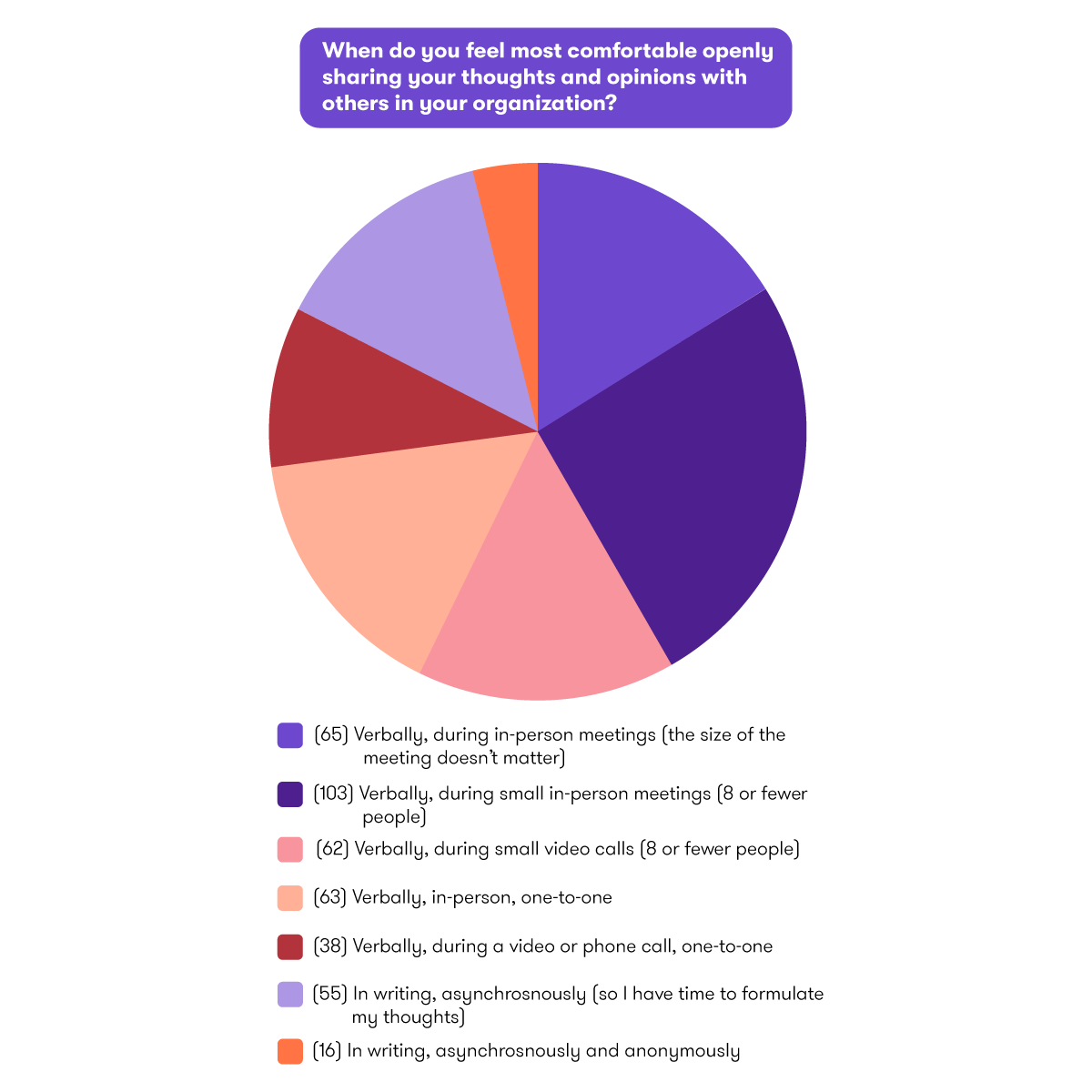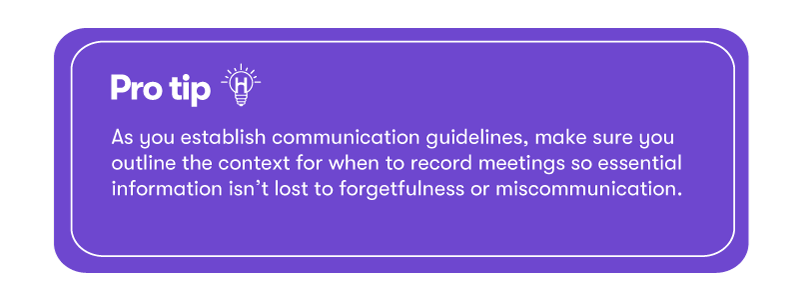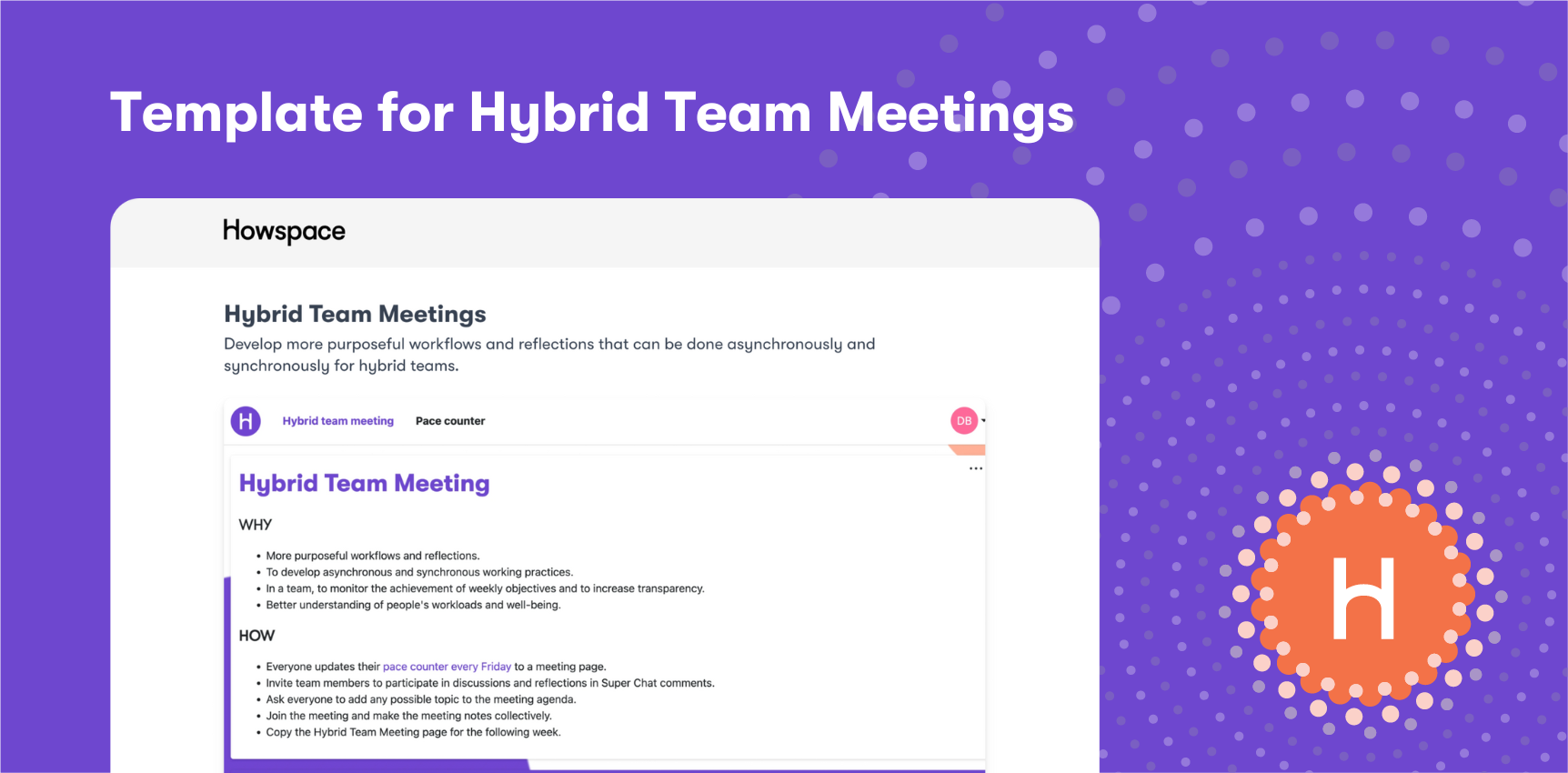
Creating a successful hybrid work environment: 5 traits you need to instill
Thinking about fleshing out a successful hybrid work environment? Good call.
81% of employees either don’t want to go back to the office or prefer a hybrid work arrangement. So it makes sense to give your employees the flexibility to either work from home or the office.
The catch? Creating a results-driving hybrid work environment isn’t a piece of cake. It takes a lot of work including plenty of feedback sourcing, understanding employee work preferences, and a significant mindset shift.
So let’s look at these specifics in this guide as we walk you through the five traits of a strong hybrid work environment and how to achieve them.
Let’s go.
If you’re looking to bring hybrid work to the next level, grab our free template for hybrid meetings!
5 traits of a successful hybrid work environment
Briefly, the five essential traits are:
Now, for the details:
1. Co-created
It’s easy to use guesswork to plan a hybrid work setting. But innovation and employee retention depend on an inclusive work environment—co-created based on everyone’s feedback.
Without it, you end up with frustration and resentment, which can quickly fracture company culture and morale. This is why the first trait of a well-oiled hybrid work model is a co-created work environment.
So how do you go about gathering feedback on what is a hybrid work environment for each employee? Actively listen to their requirements. Ask employees about their:
- Work preference. Whether remote-first, office-first, or visiting the office on set days works for them.
- Work style including how they structure their days and their most productive hours.
- The idea of what the office is to them. Whether it’s a place to collaborate or a center for building relationships with their colleagues.
Based on the feedback you get, create an inclusive hybrid work environment that’s geared toward meeting all employees’ unique requirements.
One thing you need to be mindful of: not all employees are comfortable with sharing their preferences in meetings. In fact, 71 of the 303 people we surveyed prefer sharing opinions in written format. 125, on the other hand, open up in one-to-one conversations.

Meaning: meetings aren’t enough to gather feedback. You need to dig deeper to learn individual employee preferences, which requires adopting their preferred communication style.

2. Flexible
The key to a winning work environment is trust, which comes from the second trait of a hybrid work environment: flexibility.
On paper, it may seem easy to foster flexibility. In practice, however, it can be challenging to encourage management as well as employees to trust one another.
The roadblocks? There are two—both embedded in a traditional mindset:
- Our habit of assuming things. In particular, we tend to assume that those who aren’t working on the same projects as ourselves aren’t doing productive work.
- Proximity bias or believing that being present in the office—in front of leadership—is going to help you earn brownie points leading to promotions and/or better pay.
These barriers require a mindset refresh, as our CEO, Ilkka Mäkitalo, recommends Here’s how:
- Approach what you don’t understand with curiosity
Instead of making negative assumptions, leading with this question helps: “Can you help me to understand what you are doing and why?”
- Stop assuming on-site work is productive work
Know that employees rarely spend eight hours working. In fact, humans can focus only for 4-5 hours a day at max.
Trust employees to get their work done in whatever way they feel is best . Doing so instills a sense of responsibility in them, which encourages them to complete their work—whether they’re at the office or working remotely.
- Focus on building work around your life—not the other way around
Motivate employees to do the same by modeling it to them. What’s more, give employees the freedom to plan their workdays based on their energy levels and preferences. Ultimately, this results in high work performance.
- Lastly, get out of measuring productivity
Encourage management to guide employees toward their goals, not to catch them slacking off. Take Senior HR Consultant at Folks HR, Maryse Ward’s, advice here:
“Manage results, not tasks. To achieve this, you must set specific objectives for each team member and follow up on them. Keep in touch with your people, plan group/team activities, and continue to recognize the work of your team.”
3. Mix of asynchronous and synchronous work
Another healthy trait of hybrid work is collaboration and connectivity using both asynchronous and synchronous methods.
Typically, meetings are treated as the go-to means for collaboration—no matter what the work setting is.
The reality? Unnecessary meetings lined up one after the other hurt employee focus and productivity. Consequently, workers end up doing real work over evenings and weekends.
Naturally, such a sad picture of work-life balance does little to retain employees. It also leaves little room for innovation.
So for a productive hybrid work environment, take steps to reduce notifications and limit collaboration to a few apps to streamline communication.
Here’s what to do:
- Reduce meetings
Host them only when necessary. Also, always think of how to facilitate meetings to get the most from participants. This includes asking yourself who’s actually needed in the meeting.
Moreover, cancel or reduce meetings’ size as needed. And, finally, have an agenda for each meeting so participants know what’s expected of them and can contribute meaningfully to the discussion.
- Plan all collaboration digitally so everyone’s involved and on the same page
Organize collaborative work such as brainstorming, feedback sourcing, submitting tasks, and more digitally.
Whether employees are working remotely or from the office, make it a rule to collaborate in an online workspace.
4. Connected
A top hybrid work challenge that employees report is feeling disconnected from their colleagues, according to our 2021 global Howspace survey.
Admittedly, human interaction can be limited in a remote work setting, which can stress employees. The solution? Work on intentionally building connections among a distributed workspace.
Here’s how to focus on building relationships:
- Facilitate conversations in your virtual workspace
Using a digital work platform such as Howspace, create a shared virtual space (think: online coffee chat corner) for employees to communicate and support each other.
- Regularly check in with team members
Ask them how they’re doing outside of work and what they’re struggling with on all levels—not just as employees, but as people. Offer support and ask how you can help.
- Connect on a deeper level.
This can be tricky. However, modeling the behavior helps others understand and reciprocate it until finally, it becomes a part of your hybrid work culture.
To this end, open up yourself—share a personal problem, pair up with a colleague as your accountability partner, discuss work goals, and so on.
It’s only when leadership is open that employees start to see it’s okay to open up themselves. Lastly, when engaging in conversations, take a listening-first approach.
- Foster connectivity
Host relationship-building events such as music quizzes, buddy systems, virtual coworking sessions, and coffee chats with people you don’t work with closely.
For inspiration, here’s what the Spacer team does in the words of their CEO, Michael Rosenbaum:
“Our team has an inter-department fortnightly Coffee Catch-up to give everyone the chance for chit chat and to get to know each other outside of just work. This brings together different teams who otherwise wouldn’t have the chance to work closely together.”
5. Transparent
The final trait of a successful hybrid work environment is transparency, which helps to foster trust and a sense of responsibility. As employees learn about their contributions to the company’s goals, they also feel more valued.
So here’s how to instill transparency in your work environment:
- Open up about company goals
This aligns employees with the big picture, which helps them understand the weight of their contributions. It also makes staff enthusiastic about their work, improving their commitment to the job at hand.
- Have honest conversations with your team about their concerns
This ensures you source individual employees’ opinions, preferences, concerns, and more. On the flip side, transparent conversations give employees the chance to ask questions they have and understand the decisions you’re making.
As speaker, coach, and trainer with the John Maxwell Team, Kenneth-Maxwell Nance puts it,
“The more knowledge one has of self, others, and the shared purpose, the better enabled you are to help construct an effective hybrid work model. When everyone in the organization understands the shared purposes and responsibilities, it’s easier to facilitate collaboration and engagement.”
- Set expectations around how to collaborate
For example, establish guidelines about when to use which tools for what communication.
This isn’t to limit employees’ preferred communication styles or set rigid rules. Instead, it’s setting context to save employees from confusion and overwhelm caused by having to constantly collate nuggets of information from different sources.
Doing so also maximizes the chances of employees having the full picture of what’s going on and the role they’re playing.

- Adopt a facilitator’s mindset
Lastly, be curious about others’ opinions, thoughts, and experiences and embrace vulnerability.
Adopting this mindset will help you facilitate dialogue that involves employees in decision-making and encourages them to share their opinions and ask questions.
Build a hybrid work environment today
And that’s a wrap. To quickly recap:
- Learn employees’ preferences for a hybrid work setting and their working style
- Stop making negative assumptions and start trusting
- Move all collaborative work to a digital workspace
- Connect with workers on a deeper level
- Open up about company goals and welcome all opinions and feedback
Taking these actions will help you bake the five winning traits of a hybrid work environment in your company culture in no time.
Check out our template for hybrid meetings! This template will help you create more collaborative team practices that work for everyone, no matter where they’re working from.
Already a Howspace-user? You can add the template to your account here.

You might be interested in these as well
View all
The future of learning: How to design learning experiences for the hybrid world
It’s no secret: work as we know it has changed for good. COVID-19, the Great Resignation, and the rise of […]

The future of work is more than hybrid: How to build a community-centric culture
Hybrid work has been a hot topic since the pandemic. Companies learned that work can get done even if employees […]

Find out which of these 3 hybrid work models is best for your organization
This preference for hybrid work is bringing most organizations face-to-face with a pressing question: which hybrid work model is best for your company?